Well the 108th AAVSO meeting has finished up and today we drive 2 hours from Las Cruces passed Holloman Air Force Base and Alamogordo and then passed Cloudcroft until we reached the Sunspot and Apache Point Observatories.
So a busload of AAVSO attendees boarded the bus in Las Cruces at about 3900 feet elevation and drove the two hours up through the forests to Sunspot and Apache Point Observatories at about 9200 feet elevation.
 |
| It is just a two hour drive from Las Cruces to Sunspot and Apache Point Observatories |
Various solar telescopes have been part of the Sunspot Solar Observatory on the mountain since about 1950 when the site was an Air Force Facility for monitoring the sun, which was recognized as a source of radio communication interference. The latest telescope is the Dunn Solar Telescope housed in this 136 foot tall concrete tower with 228 more feet underground.
 |
| Dunn Solar Telescope (DST) (Source: Palmia Observatory) |
Several optical paths, all in vacuum, terminate on the laboratory deck at ground level. Some tubes are used for full solar image viewing and others for much higher resolution of smaller sections of the sun.
 |
| Inside the tower view of the vacuum tubes of the Dunn Solar Telescope (Source: Palmia Observatory) |
The laboratory deck has six optical windows where six different sensors can see the sun. The photo below shows one of the optical benches setup for some experimental work.
 s s |
| View of the laboratory deck of the Dunn Solar Telescope (Palmia Observatory) |
There are many abandoned observatories at Sunspot. Some like the Evans Solar Facility, called the Big Dome, built in 1952 is abandoned now because the viewing capability has been surpassed by other instruments. You can still tour the facility, which is almost like a museum. We saw a old pen and ink chart recorder that was used to record some measurements, so it has indeed been some time since the telescope was used.
Another observatory still standing is the Grain Bin Dome, built in 1950, from a grain bin ordered from Sears and Roebuck. It is obsolete for solar studies but is still used for public start party events.
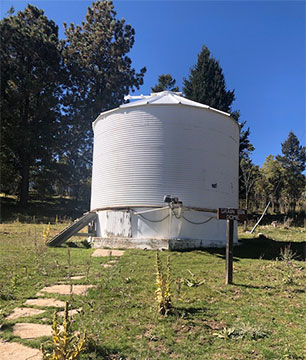 |
| Grain Bin Observatory from 1950, now used for public star parties (Source: Palmia Observatory) |
Here is another example of an observatory and office complex that is abandoned and not used. If you have been following solar telescope developments you know that the latest new solar telescope is the Daniel K. Inouye Solar Telescope (DKIST) is being built on Haleakala, Hawaii at 10000 feet elevation. The DKIST concept was reviewed in this blog in the June 8, 2018 post.
Hmm, I wonder what this latest solar scope will mean for those at Sunspot. We know there is only so much money available for solar research and older, not as effective anymore, telescopes might continue to be abandoned. It's sad, but what can be done?
 |
| Another abandoned observatory at Sunspot (Source: Palmia Observatory) |
Our first stop was at the Astrophysical Research Consortium 3.5-meter Telescope control room. A nightly observing session usually has one person in the control room and one person at the actual telescope. Time on the telescopes is assigned a quarter of the year in advance. The building where the control room is located also has a kitchen and common area for those working on the scopes. A separate dormitory building is available for engineers and other support staff as well as observers and principal investigators. The video screens shows the physical environment in the telescope dome as well as the images from cameras and instrumentation.
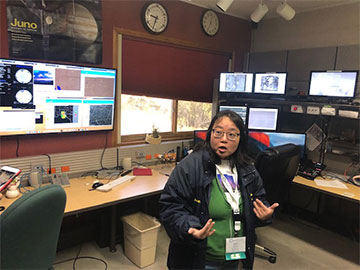 |
| Dr. Karen Kinemuchi, AAVSO and NMSU, explains the 3.5 meter telescope control room (Source: Palmia Observatory) |
The control room is connected to the telescope dome by a long enclosed pathway. We walked from the control room to the telescope dome.
 |
| Astrophysical Research Consortium 3.5-meter telescope at Apache Point (Source: Palmia Observatory) |
Finally, we get a chance to see the primary mirror, the 3.5-meter mirror shown here with its protective covers in place. What you can't see in this photo is the secondary mirror which sends the images back through the opening in the primary mirror to instrument ports on the sides of the mirror cage.
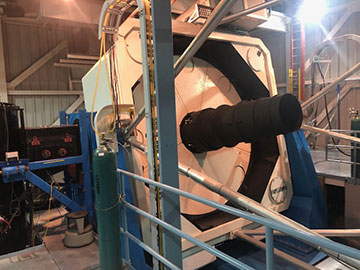 |
| Facing view of Astrophysical Research Consortium 3.5-meter primary mirror (Source: Palmia Observatory) |
So, we normally might think of the camera connected to a scope like this one as just an ordinary little camera like the ones most of us are used to connecting to small telescopes. Well, check out the camera attached to one of the viewing ports on the 3.5-meter telescope. That is one big specialized camera!
 |
| Camera attached to one of the three viewing ports (Source: Palmia Observatory) |
It also turns out that the telescope can also be fitted with eyepieces so that observers can put their own eyeballs right up to the telescope and see the image themselves. Wow, and I thought those eyepieces that we saw when we toured and experienced the 60-inch telescope on Mt. Wilson were huge, but these definitely are the hugest. The eyepieces are normally not used, but are brought out for some public viewing nights that are possible on this telescope.
 |
| Yes, those are eyepieces used for public viewing on the 3.5-meter telescope (Source: Palmia Observatory) |
Although this telescope was on a scheduled maintenance period, we were allowed to wonder all around, on the condition that we did not interfere with the ongoing maintenance. It turned out that the maintenance folks did allow us to see the primary mirror and in the photo below you can see the protective covers in the process of being opened up.
 |
| We received permission to open the 3.5-meter mirror covers (Source: Palmia Observatory) |
With the mirror covers fully opened we could see the full primary mirror. We were allowed to get up close to the mirror, so I used the opportunity to take a selfie with the help of the 3.5 meter mirror.
 |
| Resident Astronomer George takes a selfie with the help of the 3.5-meter mirror (Source: Palmia Observatory) |
There are also a couple of small aperture telescopes at Apache Point also. We didn't stop to see the 1-meter telescope, but we did stop to see this 0.5-meter telescope which is used for students from New Mexico State University (NMSU) for training.
 |
| 0.5-meter Astrophysical Research Consortium Small Aperture Telescope (Source: Palmia Observatory) |
We were given a tour of the inside of the 0.5-meter telescope also. That was pretty neat. One thing that I noticed was that the finder scope in this case was one of the Explore Scientific telescopes, just about like the one we used to use.
 | |
|
After leaving the Small Aperture Telescope we made our way down to the Sloan Foundation 2.5-meter Telescope. Ever since hearing about the Sloan Digital Sky Survey (SDSS), I always wanted to visit the observatory where all of these measurements of galactic spectra and redshift were made. Well here we are at the observatory where all of this happened.
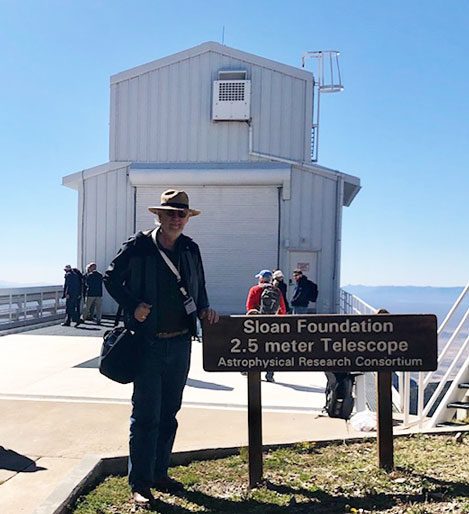 |
| Resident Astronomer George at the Sloan Foundation 2.5 meter Telescope (Source: Palmia Observatory) |
The 2.5-meter Sloan telescope was down for maintenance, but we were allowed to visit the observatory. The staff opened up the front roll up doors and the back roll up doors. From the backside we could look out over the valley and see the White Sands of New Mexico.
 |
| The rearview from the 2.5-meter observatory shows White Sands in background (Source: Palmia Observatory) |
Many of us had hoped to see the 2.5-meter scope in its nighttime configuration but this was not to be. We were lucky enough to be able to see it in its maintenance mode as the engineers tried to get it ready for that nights observing session. The image below from the APO website is the iconic image that I had come to expect. During a nighttime observing session the building covering the telescope slides out of the way allowing the telescope a clear view of the sky.
 |
| This is what the 2.5 meter Sloan Foundation Telescope looks like when operating (Source: www.apo.nmsu.edu) |
But the observing team let us into the observatory as the engineers continued their troubleshooting.
 |
| The Sloan 2.5-meter telescope in maintenance position (Source: Palmia Observatory) |
We could not see the primary mirror, but fortunately we could see the cartridge that held the disk where all of the fiber optic cables, one for each of the galaxies targeted for that observation period, were housed and then with the other fiber end connected to the spectrometer or other instrument that was assigned. The cylindrical black cartridge in the photo below is where all the light from of the assigned targets was directed to the assigned instrument.
 |
| The black cylindrical cartridge has the fiber optic sky disk (Source: Palmia Observatory) |
So, that black cartridge holds the fiber optic plug disks that enable measure about a 1000 spectra from one position in the sky per disk. Readers may recall that I picked up one of the used disks as they were being given away at a previous AAS meeting. In the photo below you can see my disk #2727 was used for one set of spectra measurements. The details of that disk can be found in blog postings of January 16 and January 20, 2019.
 |
| Resident Astronomer George holds one of the disks given away at an AAS meeting (Source: Palmia Observatory) |
Ok, the next stop on our tour was in the room where all of the fiber optic cables are inserted or plugged into the disks that will eventually be used for some one particular position in the sky. In this photo you can see two technicians plugging fiber optic cables and getting a fresh disk ready for plugging also. Notice the long row of disks in the background. The technicians said that the observation schedule can go through 8 disks per night, sometimes 12-13 per night. So you can see he observing schedule needs some careful planning to select the targets for each observing period, then drilling the disks with the position of each target, then plugging each disk with fiber cables, and then testing and identifying in which hole each fiber has been placed. Various combinations of holes represent targets for some one principal investigator and are identified by color. The technicians said that they don't make too many mistakes, like when they are down to the last fiber and it is not the right color for the available hole, but they can usually spot where they went wrong and fix it before the calibration and alignment step for all cables. I didn't notice the exact number for this particular disk, but it was up in the 8000's, so a lot of observations have been done since my disk #2727 was used. I also asked about the patterns that were drawn on the disk and they said it was just to help group the fiber cables so they laid out in an easier pattern. Other than the color, the fibers can be placed on any available hole without any other thought because registration happens latter.
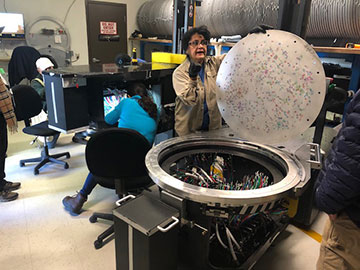 |
| Technicians preparing and plugging fiber optic cables in disk for use that evening (Source: Palmia Observatory) |
Ok, that is about all the main topics for this posting. When we all got back on the bus to return to Las Cruces, I couldn't help but stop to admire the sundial. Hey, it seems to be pretty accurate. I could read of the sundial that it said about 2:15PM and the indicated date was (about) October 20 and the analemma said to subtract 15 minutes. So the sundial said it was about 2:00PM and my iPhone said it was 3:01PM. Hmm, ok, I see, we are on daylight savings time and we should subtract one hour from the iPhone reading. Ok, the sundial is pretty accurate and does not need battery charging! It doesn't however work at night!
 |
| Sundial clock at Sunspot Visitor Center (Source: Palmia Observatory) |
So, that is the brief summary of the tour which was the final part of the AAVSO meeting. It was a great event and just enjoying the New Mexico scenery and dark skies made it very enjoyable. Next up on this adventure is the Nightfall Star Party in Borrego Springs. See you all there!
Until next time,
Resident Astronomer George
Be sure to check out over 300 other blog posts on similar topics
If you are interested in things astronomical or in astrophysics and cosmology
Check out this blog at www.palmiaobservatory.com

That is an amazing place. The legendary astronomers James Gunn and James Westphal were in on the development of the SLOAN scope, if I am not mistaken.
ReplyDelete